Growing a dwarf lemon tree can be a rewarding experience, but it requires some patience and dedication from the gardener. The key to success is providing the tree with the right conditions and pruning it regularly. In order to achieve optimal growth for your tree, you’ll need to keep it in an area of partial shade during the hottest parts of the day, water it consistently, and provide it with quality soil for nutrition. Let’s take a look at the steps you should take to grow the perfect dwarf lemon tree.
Choose the Right Variety
The first step in growing a dwarf lemon tree is choosing the right variety. There are a few different types of dwarf tree available, including Meyer, Lisbon, and Bearss. Meyer trees can be kept to a maximum of 8 feet in size and produce small, sweet-tart fruits, while larger Lisbon trees can reach up to 12 feet in height and produce larger, acidic fruits. Bearss trees are the largest variety and can grow to over 20 feet in height, but produce very sweet lemons.
Prepare the Site
Once you’ve chosen the right variety for your needs, it’s time to prepare the area for planting. You’ll need to dig a hole that’s about twice as wide as the tree’s root ball and just as deep. Mix in a few handfuls of compost or aged manure to help with drainage and aeration. Make sure the tree is firmly planted in the ground and the soil is not too loose or too tightly packed.
Water the Tree
Your newly-planted lemon tree needs a consistent supply of water to remain healthy. The soil should be kept moist, but not soggy. Feed the tree a mixture of water-soluble fertilizer every two weeks during the spring and summer months and reduce the frequency in the fall and winter. Make sure the tree gets an inch of water every week, either from rainfall or from your sprinkler or a soaker hose.
Provide Shade and Protection
It’s very important to protect your lemon tree from the hot midday sun by providing it with some shade. An easy way to do this is by planting other larger plants or trees nearby to create a canopy of shade. You may also want to consider putting a shade cloth over the tree during the hottest parts of the day. Additionally, you should protect the tree from strong winds and cold weather by wrapping it in burlap or other such protective material.
Regular Pruning
Proper pruning is essential for any citrus tree, and dwarf lemon trees are no exception. Prune your tree regularly to maintain a compact shape and optimal growth. Remove any dead or diseased branches and stems and make sure the tree is not overgrown. Pruning should be done at least once a year to keep your tree in good condition.
Fertilization
Fertilizing your lemon tree is an important part of its care. A slow-release fertilizer should be used to feed your tree throughout the year. Make sure to use a fertilizer specifically made for citrus trees, as this will ensure your tree is getting the nutrients it needs to remain healthy. Apply the fertilizer every two months during the growing season and reduce the frequency in the winter.
Pest and Disease Control
Like all plants, your lemon tree can sometimes be vulnerable to insect infestations and diseases. Before planting, make sure the tree is healthy and free from any pests or diseases. Monitor the tree regularly for signs of pests and diseases, such as wilting leaves, discoloration, and stunted growth. If you find any pests or diseases, take immediate action to get rid of them. Apply an insecticide or fungicide, depending on the type of pest or disease.
Proper Sunlight Exposure
The key to a healthy lemon tree is providing it with optimal sunlight. Dwarf lemon trees need at least 6 to 8 hours of full sun daily, however, they can tolerate partial shade during the hottest parts of the day. Plant the tree in an area of the garden that gets a lot of light, preferably one that receives sun in the morning and afternoon.
Proper Soil Conditions
The soil in which the lemon tree is planted should provide good drainage to ensure the tree does not become waterlogged. The soil needs to be able to retain some moisture, but not become soggy. The ideal soil for a lemon tree should be slightly acidic, with a pH of 6.0 to 6.5. You can measure the pH level of the soil with a pH testing kit available at most garden centres.
Growth Stimulants
Once your lemon tree is properly planted and taken care of, you can use certain growth stimulants to ensure it receives the nutrients it needs. These include seaweed extract, humic acid, and compost tea. These growth stimulants should be used every 2 to 4 weeks throughout the growing season, depending on the type. Always read and follow the instructions on the package carefully.
Fruit Formation
Once your lemon tree is mature enough and produces healthy foliage, you may begin to notice tiny fruits forming. The best time to harvest the fruits is when they have fully ripened. You can tell when the lemons are ripe, as the fruits are larger, sweeter-tasting, and have a deep yellow color. Once picked, store them in a cool, dry place and consume within a few days.
Preventing Frost Damage
Finally, if you live in an area with cold winters, you will need to take extra precautions to ensure your lemon tree is protected from frost damage. You can do this by applying a thick layer of mulch around the base of the tree, which will act as an insulating layer. You may also need to cover the tree with a frost cloth when temperatures drop below freezing.


